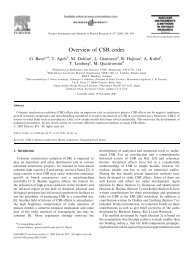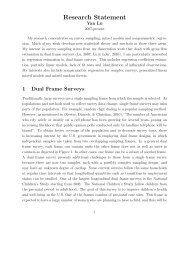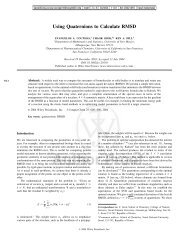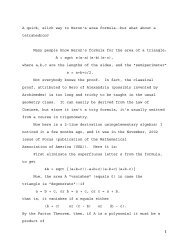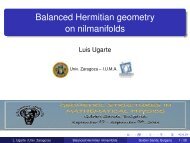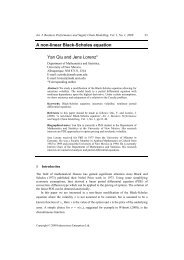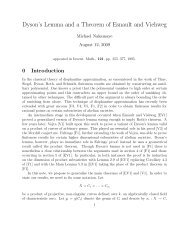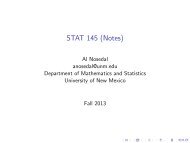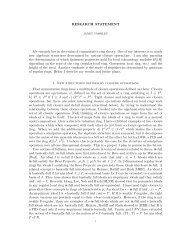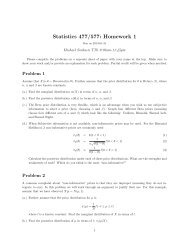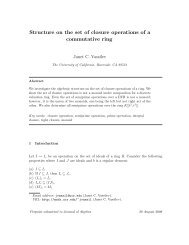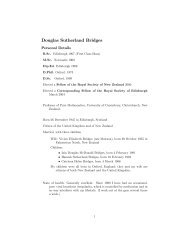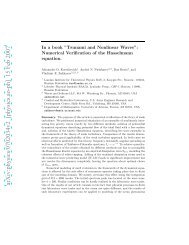OEO Office of Equal Opportunity - Department of Mathematics and ...
OEO Office of Equal Opportunity - Department of Mathematics and ...
OEO Office of Equal Opportunity - Department of Mathematics and ...
You also want an ePaper? Increase the reach of your titles
YUMPU automatically turns print PDFs into web optimized ePapers that Google loves.
PHYSICS AND ASTRONOMY 267<br />
566. Quantum Optics. (3 to a maximum <strong>of</strong> 6) ∆ ††<br />
Study <strong>and</strong> manipulation <strong>of</strong> quantum coherence with electromagnetic<br />
fields. Quantum coherent spectroscopy; photon<br />
statistics <strong>and</strong> nonclassical light; open quantum systems;<br />
decoherence; special topics. {Alternate Years}<br />
568. Nonlinear Optics. (3)<br />
(Also <strong>of</strong>fered as ECE 568.) General concepts, microscopic<br />
approach, nonlinear optical effects <strong>and</strong> devices. {Alternate<br />
Springs}<br />
569. Advanced Topics in Modern Optics. (3 to a maximum<br />
<strong>of</strong> 6) ∆ ††<br />
Possible topics include dye lasers, solid-state lasers, novel<br />
lasers, interaction between intense lasers <strong>and</strong> matter, advanced<br />
nonlinear optics spectroscopy. {Offered upon dem<strong>and</strong>}<br />
570. Theory <strong>of</strong> Relativity. (3)<br />
Einstein’s theory <strong>of</strong> general relativity both as a theoretical<br />
model for gravitational forces via curved space times <strong>and</strong> as<br />
applied to various realistic astrophysical situations such as<br />
neutron stars, black holes <strong>and</strong> gravitational waves. {Offered<br />
upon dem<strong>and</strong>}<br />
573. Classical Mechanics II. (3)<br />
Introduction to methods <strong>and</strong> topics <strong>of</strong> current interest in classical<br />
mechanics, particularly methods <strong>of</strong> advanced Hamiltonian<br />
mechanics <strong>and</strong> topics related to nonlinear dynamics <strong>and</strong><br />
chaos in Hamiltonian <strong>and</strong> dissipative systems.<br />
Prerequisite: 503. {Alternate years}<br />
576. Advanced Statistical Mechanics. (3)<br />
Introduction to topics <strong>and</strong> methods <strong>of</strong> current areas <strong>of</strong> interest<br />
in statistical mechanics, particularly the area <strong>of</strong> cooperative<br />
phenomena <strong>and</strong> the area <strong>of</strong> nonequilibrium (time-dependent)<br />
statistical mechanics. {Alternate years}<br />
Prerequisite: 505.<br />
580. Advanced Plasma Physics. (3)<br />
(Also <strong>of</strong>fered as CHNE, ECE 580.) Plasma kinetics equations,<br />
Vlasov theories <strong>of</strong> plasma waves <strong>and</strong> microinstabilities,<br />
L<strong>and</strong>au damping, nonlinear evolution <strong>of</strong> instabilities, turbulence,<br />
applications, transport in fluid plasmas; Fokker-Planck,<br />
Krook collision model.<br />
Prerequisites: 534, 535. {Offered upon dem<strong>and</strong>}<br />
581. Advanced Topics in Physics <strong>and</strong> Astrophysics. (3<br />
to a maximum <strong>of</strong> 12) ∆<br />
599. Master’s Thesis. (1-6)<br />
May be repeated to a maximum <strong>of</strong> 12 hours, but only 6<br />
hours will count toward the program <strong>of</strong> studies. Offered on<br />
a CR/NC basis only.<br />
650. Research. (1-12 to a maximum <strong>of</strong> 24) ∆<br />
May be repeated with any single faculty member.<br />
699. Dissertation. (3-12)<br />
Offered on a CR/NC basis only.<br />
Astronomy/Astrophysics (ASTR)<br />
For ASTR 101 through 109 see the general interest courses<br />
described above.<br />
270. General Astronomy. (3)<br />
Concepts <strong>of</strong> astronomy with emphasis on the Solar System.<br />
Pre- or corequisites: MATH 150 or 162 <strong>and</strong> any physics<br />
course numbered 150 or higher. {Fall}<br />
270L. General Astronomy Laboratory I. (1)<br />
Observations <strong>of</strong> the moon, planets <strong>and</strong> stars.<br />
Pre- or corequisite: 270. Three hrs. lab. {Fall}<br />
271. General Astronomy. (3)<br />
Stellar astronomy, the galaxy, extra-galactic systems, cosmology.<br />
Pre- or corequisites: (MATH 150 or 162) <strong>and</strong> any physics<br />
course numbered 150 or higher. {Spring}<br />
271L. General Astronomy Laboratory. (1)<br />
Observations <strong>of</strong> the moon, planets <strong>and</strong> stars.<br />
Pre- or corequisite: 271. Three hrs. lab. {Spring} .<br />
*421. Concepts <strong>of</strong> Astrophysics. (3)<br />
Gravitation, radiation, relativity, stellar atmospheres, structure,<br />
<strong>and</strong> evolution.<br />
Prerequisite: PHYC 330. {Fall}<br />
*422. Stars <strong>and</strong> Stellar Systems. (3 to a maximum <strong>of</strong><br />
6) ∆ ††<br />
Applications <strong>of</strong> advanced astrophysical concepts to the<br />
interstellar medium, star formation, the Milky Way, external<br />
galaxies, <strong>and</strong> cosmology.<br />
Prerequisite: 421. {Spring}<br />
*423. Radio Astronomy. (3)<br />
Single dish <strong>and</strong> aperture synthesis radio observations; emission<br />
processes at radio wavelengths: synchrotron radiation,<br />
thermal bremsstrahlung.<br />
Prerequisites: PHYC 330. {Spring}<br />
*424. Extragalactic Astronomy <strong>and</strong> Cosmology. (3) †<br />
Distribution, properties <strong>and</strong> interactions <strong>of</strong> galaxies <strong>and</strong><br />
quasars; large scale clusterings <strong>of</strong> matter, formation <strong>and</strong><br />
evolution <strong>of</strong> the universe; physical cosmology. {Offered upon<br />
dem<strong>and</strong>}<br />
*425. Galactic Astronomy. (3)<br />
The observed <strong>and</strong> inferred structure, kinematics <strong>and</strong> evolution<br />
<strong>of</strong> our galaxy. {Offered upon dem<strong>and</strong>}<br />
*426. Optics <strong>and</strong> Instrumentation. (3) †<br />
Principles <strong>of</strong> optics <strong>and</strong> quantum physics applied to modern<br />
astronomical instrumentation (over a wide range <strong>of</strong> electromagnetic<br />
wavelengths), data acquisition <strong>and</strong> processing.<br />
{Offered upon dem<strong>and</strong>}<br />
*427. Topics in Planetary Astronomy. [Selected Topics in<br />
Planetary Astronomy.] (3 to maximum <strong>of</strong> 12) [3] ∆ †<br />
Planetary physics; planetary investigation using space vehicles;<br />
optical properties <strong>of</strong> planetary atmospheres. {Offered<br />
upon dem<strong>and</strong>}<br />
*445. Introduction to Cosmic Radiation. (3)<br />
(Also <strong>of</strong>fered as PHYC 445.) Primary cosmic radiation,<br />
Stormer theory, production <strong>and</strong> detection <strong>of</strong> secondary cosmic<br />
radiation, meteorological <strong>and</strong> environmental effects, temporal<br />
variations, heliospheric transport, extensive air showers<br />
<strong>and</strong> origin <strong>of</strong> cosmic rays. {Offered upon dem<strong>and</strong>}<br />
*455. Problems. (1-3 to a maximum <strong>of</strong> 6) ∆<br />
456. Honors Problems. (1 to a maximum <strong>of</strong> 2) ∆<br />
(Also <strong>of</strong>fered as PHYC 456.) Independent studies course for<br />
students seeking departmental honors.<br />
534. Plasma Physics I. (3)<br />
(Also <strong>of</strong>fered as CHNE, PHYC, ECE 534.) Plasma parameters,<br />
adiabatic invariants, orbit theory, plasma oscillations,<br />
hydromagnetic waves, plasma transport, stability, kinetic<br />
theory, nonlinear effects, applications.<br />
Restriction: permission <strong>of</strong> instructor. {Fall}<br />
536. Advanced Astrophysics I. (3)<br />
(Also <strong>of</strong>fered as PHYC 536.) Astrophysical problems as<br />
illustrations <strong>of</strong> classical <strong>and</strong> statistical mechanics, as well<br />
as E&M: expansion <strong>of</strong> the universe; dark matter; big-bang<br />
nucleosynthesis; interiors <strong>of</strong> white dwarfs <strong>and</strong> neutron stars;<br />
supernova explosions; formation <strong>of</strong> galaxies. {Alternate<br />
Falls}<br />
537. Advanced Astrophysics II. (3) †<br />
(Also <strong>of</strong>fered as PHYC 537.) Astrophysical problems as illustrations<br />
<strong>of</strong> quantum mechanics; hydrogen <strong>and</strong> other atoms;<br />
molecules; spectral lines in the astrophysical environment;<br />
Doppler effect; ionized regions surrounding stars; centers <strong>of</strong><br />
active galaxies; Lyman alpha forest; non-Keplerian rotation<br />
<strong>of</strong> galaxies.<br />
Prerequisite: PHYC 521. {Alternate Springs}<br />
ARTS AND<br />
SCIENCES<br />
UNM CATALOG 2006–2007 Symbols, page 611.



